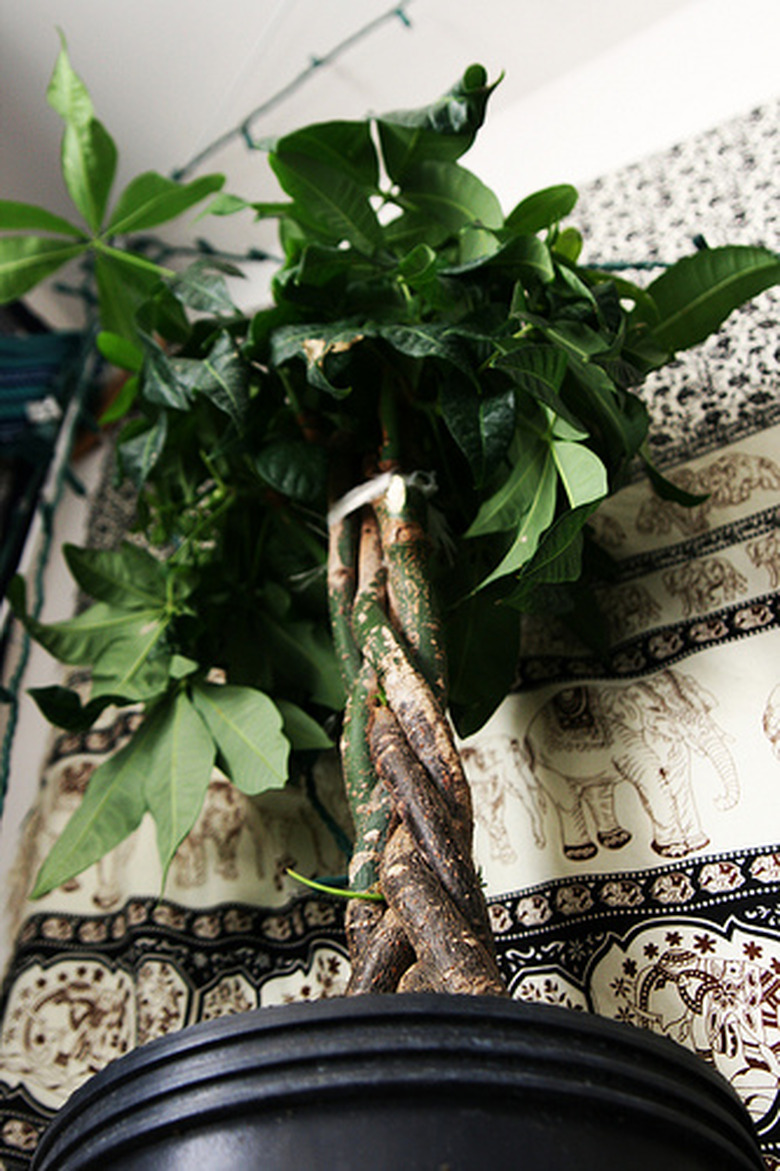How To Care For Money Tree Plants
Things Needed
- Money tree
- Potting container
- Soil
- Small pebbles
- Water
- Fertilizer
The money tree, also known as Pachira aquatica, is a bonsai tree that varies from very small to quite large in size. The money tree embraces the elements of feng shui and is a relatively easy plant to care for. Although native to China's wildlife, it is a plant that thrives well in a container.
Step 1
Ensure the proper container. If the plant is delivered in a small pot, immediately transfer the plant in a medium container using the soil in which it is delivered, along with free soil. This will allow its roots to stretch and thrive. The new pot should be two sizes larger in diameter than the original pot. The plant has no known diseases or toxins so any type of pot will suffice, such as plastic, metal or ceramic. Include one or two small drain holes to allow proper distribution of water throughout the plant.
- The money tree, also known as Pachira aquatica, is a bonsai tree that varies from very small to quite large in size.
- The plant has no known diseases or toxins so any type of pot will suffice, such as plastic, metal or ceramic.
Step 2
Prepare the proper soil mixture for the money tree plant. The soil should include a combination of earth and gravel; a combination of 1/3 pebbles to 2/3 soil is acceptable. Fertile earth is acceptable soil if the pH levels rests between 5.0 and 7.0. If not, begin a bag of purchased soil that includes a standard growing formula.
Step 3
Place the tree in an area of your home or yard that allows the plant to receive indirect sunlight for at least 6 hours per day. The plant can tolerate a few hours of direct sunlight; however, the leaves of the money tree are gentle and direct sunlight can cause the leaves to sunburn. Though the plant prefers indirect sunlight, it is a tree native to warm climates, so avoid temperatures below 50 degree Fahrenheit.
- Prepare the proper soil mixture for the money tree plant.
- Place the tree in an area of your home or yard that allows the plant to receive indirect sunlight for at least 6 hours per day.
Step 4
Water your tree no more than once a week, depending on it size.The money tree does not require a large amount of water. Smaller trees should be watered two or three times per month. Do not water the tree until the soil is completely dried out from the previous watering. If the leaves droop and turn a yellowish color, the plant is getting too much water. Allow the soil to completely dry out before its next watering. If the leaves become wrinkly and begin to curl, it is under-watered. Water the tree, starting with one cup of water and increase slowly, as needed. Wait an hour. If you see the tension of the plant begin to release, it has plenty of water. If the tension does not show reduction, add another cup of water to the plant and revisit it the following day. Repeat as necessary until the plant shows signs of coming out of its drought. Still, be careful not to over-water. It is best to water the tree from the bottom of the container. Do not allow the tree to sit in watered pans and drain excessive water immediately.
- Water your tree no more than once a week, depending on it size.
- Water the tree, starting with one cup of water and increase slowly, as needed.
Step 5
Limit your tree's fertilization. The money tree does not require fertilizer. However, if you choose to fertilize your tree, limit the fertilization to twice per year and avoid fertilizing during its blossoming period. Use a slow-releasing fertilizer that has very low levels of nitrogen. Mature trees have blossoms that last for only one day. The blossom will result in the development of an edible nut. However, these blossoms and nuts are uncommon in indoor environments.
- Limit your tree's fertilization.
- The blossom will result in the development of an edible nut.
Step 6
Prune your money tree based on your personal choices. If you prefer an increase of new growth, prune the large leaves from the tree. Trim old and wilted leaves from the tree immediately. The branches of the money tree are naturally limber and are easily braided. Though not required, many people choose to braid the trunks of multiple trees. Braiding trees reinforces aspects of feng shui and provides an exquisite appearance to your tree.
